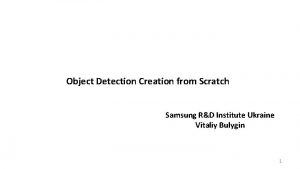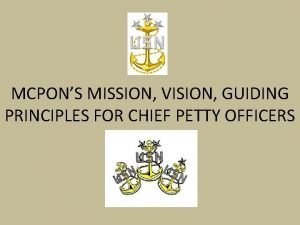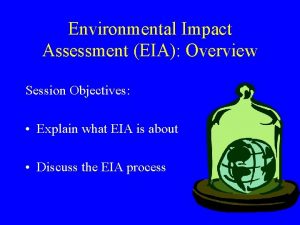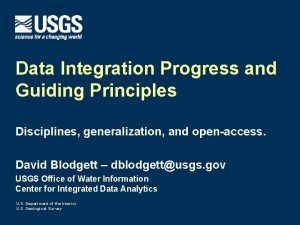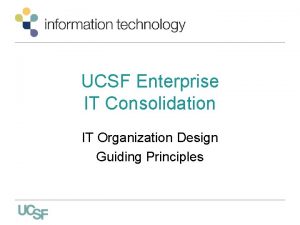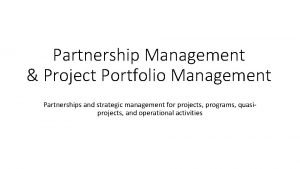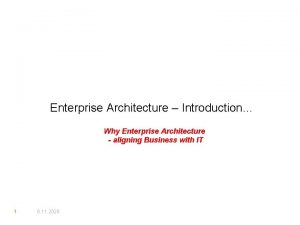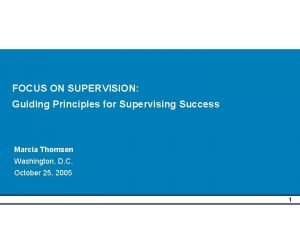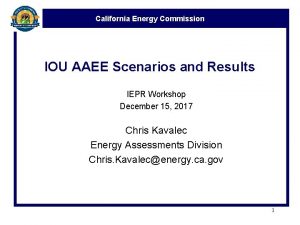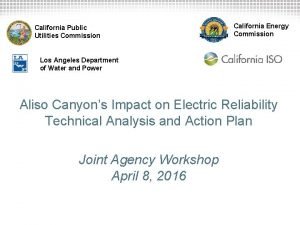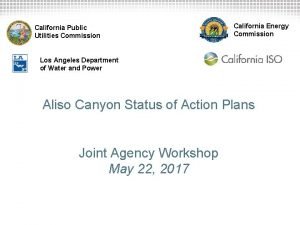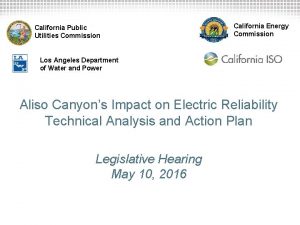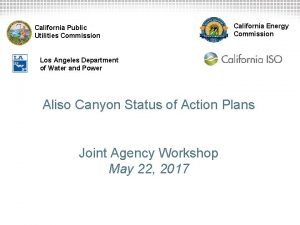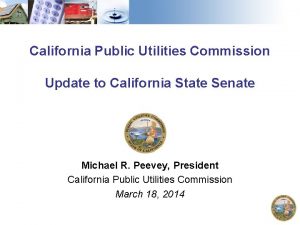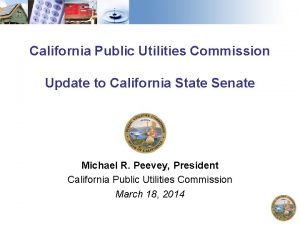California Investor Owned Utilities IOU HAN Guiding Principles















- Slides: 15

California Investor Owned Utilities (IOU) HAN Guiding Principles Functional Characteristics and System Criteria 2 July 2007 1

Introduction Ø Presentation Purpose: Ø Ø Information sharing Validate approach Drive technology implementations Establish participation and responsibility Ø Outline: Ø Ø Ø June 2007 Framework introduction Documentation Purpose Documentation process Guiding principles Functional Characteristics Next Steps 2

Utility HAN Framework Ø Ø Ø Based on Strategic Planning and System Engineering Each level provides direction and context for lower level Delineates participation and accountability Can be mapped to Grid. Wise Architecture Framework (Loosely coupled - Decomposition framework vs. organizational interoperability view) Stakeholder considerations at every level: regulators, consumers, utilities, vendors June 2007 3

Document Purpose Ø Describes utility’s view of HAN Ø Establishes participation scope and scale Ø Intended audience: Ø Regulators – establish position, clarify roles and responsibility Ø Open. HAN – creates input for further system refinement (e. g. , platform independent requirements, use cases) Ø Vendors – shows approach, motivation Ø Establishes a baseline Ø Time management: cuts down on clarification meetings and phone calls June 2007 4

Documentation Process June 2007 5

HAN Guiding Principles Value Proposition Guiding Principles Functional Characteristics & Criteria Platform Independent Requirements Platform Requirements (Technology Specific) June 2007 6

HAN Guiding Principles Ø Ø Ø Ø Ø June 2007 Capabilities Supports secure two way communication between the AMI Network and HAN Supports load control integration (e. g. Distributed Resource dispatch / control / relaying) Provides direct access to usage and other meter data (e. g. k. WHr, k. W, Voltage, etc. ) Provides a platform for future customer owned products which leverage meter data and utility/grid information Supports three types of communications: public price signaling, consumer specific signaling and control signaling Supports communications to other HAN Devices with metering capability (e. g. other entity gas and/or water meters, EV sub-metering, PV sub-metering, etc. ) Assumptions Consumer owns the HAN (i. e. consumer may grant permission to use/manage/integrate the HAN Devices to enable programs / rates) AMI Network to HAN Interface is based on open standards Implementation is appropriate given the high value and relative low cost Potential technology obsolescence is low due to multiple bridging options 7

HAN Functional Characteristics Value Proposition Guiding Principles Functional Characteristics & Criteria Platform Independent Requirements Platform Requirements (Technology Specific) June 2007 8

HAN Functional Characteristics and System Criteria June 2007 9

HAN Application Characteristics Ø Control - Applications that respond to control commands Ø Ø Measurement & Monitoring - Applications that provide internal data & status Ø Ø Ø Ø Energy Cost - Calculates current and overall energy cost Energy Consumption - Calculates current and overall energy consumption Energy Production - Calculates current and overall energy Production Energy Optimization - Utilizes external and HAN data to determine desired response based on a consumer configurable profile Energy Demand Reduction - Uses external and HAN data to reduce load based on a consumer configurable profile Environmental Impact - Calculates environmental impact of current energy consumption (e. g. Power Generation Plant CO 2 emissions related to consumer specific load) Human Machine Interface (HMI) - Applications that provide local user input and/or output. These applications are based constrained and based on the data type Ø Ø June 2007 Distributed generation (DG) - Local energy input/output (k. Wh, k. W, other energy values) Sub-metering - Device specific, end-use energy consumption or production (e. g. Consumer PHEV) Environmental State - Current local conditions (e. g. , temperature, humidity, time, airflow, ambient light level, motion) Device State - The current or historical state of the device (e. g. , lights/fans/compressor/motor/heater are on/off) Processing - Applications that consume, process and act on external and internal data. These applications accept data from external systems and HAN measurement & monitoring applications. In general, these applications that have a higher level of complexity and cost. Ø Ø Ø Direct - Turns load On or Off Cycling - Turns load On or Off at configurable time intervals Limiting - Turns load On or Off based on configurable thresholds User Input - Provides consumers with a means to input data into an Application (e. g. , Touch screen, Keypad) User Output - Provides an Application with a means to output data to the consumer (e. g. , In-Home Display, text message) 10

HAN Communications Ø Discovery - The identification of new nodes within the HAN Ø Announcement – both active and passive device notification methods Ø Response - Includes both endpoints (e. g. , announcing entity and recipient entity) Ø Initial Identification - Device-type and address identification Ø Commissioning - The network process of adding or removing a node on the HAN with the expectation that the system is self-organizing (i. e. , initial communication path configuration). This process is decoupled from utility registration. Ø Identification - Uniquely identifying the device Ø Authentication - Validation of the device (e. g. , the network key) Ø Configuration - Establishing device parameters (e. g. , network ID, initial path, bindings) Ø Control Autonomous functions enabled by the platform specific technology Ø Organization - Communication paths (e. g. , route) Ø Optimization - Path selection Ø Prioritization - Communication based on importance (e. g. , queuing, scheduling, traffic shaping) Ø Mitigation - Ability to adapt in response to interference or range constraints through detection and analysis of environmental conditions June 2007 11

HAN Security Ø Access Controls and Confidentiality – protection methods associated with both data-at-rest and data-in-transit based on data type Ø Public Controls (low robustness) - protection methods for publicly available information (e. g. , energy price) Ø Private Controls (medium robustness) - protection methods for confidential or sensitive data (e. g. , consumer usage) Ø Utility Controls (high robustness) - protection methods for utility accountable data (e. g. , load control, sub-metering data) Ø Registration and Authentication – Verifying and validated HAN participation Ø Initialization – establishes the application/device as a validated node (i. e. , logical join to the utility’s network) Ø Validation – validates the application’s data (i. e. , request or response) Ø Correlation – correlating an account (e. g. , consumer) with a device, application or program (e. g. , DR programs, peak time rebate, etc. ) Ø Authorization – rights granted to the applications Ø Revocation – removing an established node, correlation or authorization Ø Integrity – Preserves the HAN operating environment Ø Resistance – methods which prevent changes to the application or application’s data (e. g. , tamper and compromise resistance) Ø Recovery – restores an application or the application’s data to a previous or desired state (e. g. , reloading an application, resending corrupted communications) Ø Accountability – monitoring malicious activities Ø Audit – application log detected compromise attempts Ø Non-repudiation – applications and application operators are responsible for actions (e. g. , can not deny receipt or response) June 2007 12

HAN Performance Ø Availability - The applications are consistently reachable Ø Reliability - The applications are designed and manufactured to be durable and resilient Ø Maintainability - The applications are designed to be easily diagnosed and managed Ø Scalability - The system supports a reasonable amount of growth in applications and devices Ø Upgradeability - The applications have a reasonable amount of remote upgradeability (e. g. , patches, updates, enhancements) Ø Quality - The applications will perform as advertised June 2007 13

HAN Operations, Maintenance and Logistics Ø Manufacturing and Distribution - Vendor’s pre-installation activities Ø Pre-commissioning - Depot level configuration setting Ø Registration configuration - Any required utility specific configurations Ø Labeling - Utility compliance and standards labeling Ø Purchasing - Supports multiple distribution channels (e. g. , retail, wholesale, utility) Ø Installation - physical placement of the device Ø Documentation - Installation materials and manuals Ø Support Systems - Installation support systems including web support, help line, other third party systems Ø Management and Diagnostics Ø Alarming and logging - Event driven consumer and utility notifications Ø Testing - System and device testing Ø Device reset - Resets the device to the installation state June 2007 14

Next Steps Ø Publish CA IOU Vision statement (Guiding Principles, Functional Characteristics) Ø Develop Open. HAN comprehensive HAN use cases Ø Develop Open. HAN platform independent requirements Ø Develop Utility. AMI platform independent architectural views for AMI and HAN Ø Continue to share information with technology communities (i. e. , vendors, alliances) June 2007 15
 Words end with ious
Words end with ious Iou
Iou Sendai framework guiding principles
Sendai framework guiding principles Wmels performance standards
Wmels performance standards Guiding principles of ncf 2005
Guiding principles of ncf 2005 Guiding principles for teaching and learning in mtb-mle pdf
Guiding principles for teaching and learning in mtb-mle pdf Mcpons guiding principles
Mcpons guiding principles Evolution of eia
Evolution of eia Integration guiding principles
Integration guiding principles Org design guiding principles
Org design guiding principles Project portfolio management guiding principles
Project portfolio management guiding principles Enterprise architecture business and it alignment
Enterprise architecture business and it alignment Guiding principles for dual language education
Guiding principles for dual language education Na guiding principals
Na guiding principals Guiding principles of supervision
Guiding principles of supervision Principles of eia
Principles of eia

